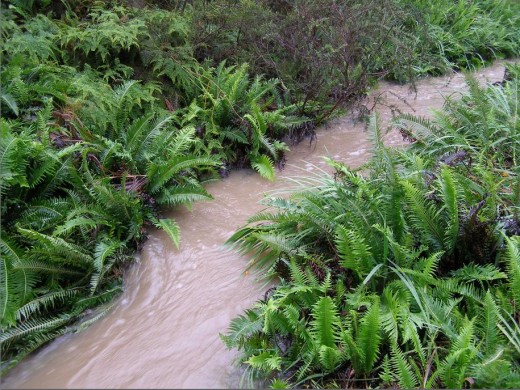Forest Giant
.
You have stood there for centuries
arms gaunt reaching the sky
your roots in candence
with the heart beat of the soil
High on the hill, you missed
the faller’s axe and saw
But they destroyed the others
down the slope
and on the valley floor
Now you and I
bleed in sorrow and in silence
for what once had been
while the rapists still
stride across
and desecrate the land.
.
~ by Australian poet Jack Davis AO.
.
The New South Wales Government’s fettish for building expressways to solve the State’s transportation problems – ignores the benefits of rail solutions, ignores the amenity and heritage rights of local communities and is destroying natural heritage. The NSW Government’s Road and Traffic Authority is arrogantly bulldozing its way through the Blue Mountains west of Sydney, destroying everything in its path. Its four lane expressway is primarily about encouraging larger and faster trucks through the Blue Mountains.
One of the oldest trees in the Blue Mountains still growing alongside the highway is a mature smooth barked apple tree (Angophora costata) situated in the hamlet of Bullaburra. The tree is a magnificent surviving remnant of an angophora forest that once dominated the locality. A qualified level 5 arborist with expertise in Australian native trees in the area has extimated the tree to be well over 200 years old and possibly more than 300 years old. This means the tree predates colonial settlement in Australia, when only Aboriginal Australians (Gundungurra and Dharug peoples) roamed the region.
The RTA has targeted the tree to be killed so that it can convert the highway into a B-Double truck expressway. The expressway under construction through the Blue Mountains feeds traffic into a heavily congested Sydney, so the billions spent to save a few minutes in the journey is lost on reaching Sydney. When the fuel price reaches $3 a litre, the cost of road freight will make road-carted produce and commodities uncompetitive. The arrogant NSW Government has no respect for natural heritage, for local communities and is backward in its 20th Century road-centric thinking.

Bullaburra’s Angophora
[Photo by editor 28th December 2006 – photo free on public domain (click to enlarge).
.

.
Decades of complacency and naivety, or do residents of bucolic Bullaburra simply deserve rights to quiet enjoyment and their buena vista? The RTA highway juggernaut is at the door. It won’t just ‘bisect’ the community [‘Anger at RTA‘ BMG 1-Oct-08]; it will permanently segregate it, raze its rural amenity and degrade it into a noisy truck side stop. Bullaburra is set to receive the same utility vision imposed on Blaxland and so many other Mountains communities.
I too attended the August township meeting at Bullaburra’s Progress Association hall, not as a Bullaburra resident, nonetheless as a Mountains resident. At the packed meeting, Bullabarrans unanimously endorsed an alternative plan asking the RTA to accommodate local linkages across what will become another four-lane barrier dividing a local community. Personal experience in dealing with the RTA at Leura, Medlow Bath and Katoomba affirms it doesn’t listen or care. It has just plundered the rare 1820s convict road at Leura, hardly pausing its schedule.
The RTA’s massive budget is only limited by political will. It stands to be key recipient of the new Building Australia Fund of $22,000,000,000 then claims it can’t afford community bridges. Be clear, the RTA’s mandate for ‘progress’ is to build more expressways. Driven by road lobbyists, the RTA is extending greater Sydney’s swelling suburbia like Roman legions extended empire. ‘Few understand how much transport influences land use patterns. Transport leads land use. Once an expressway or railway is built, it is easy to change the zoning and development laws to increase the population along the corridor.’ [Frank Sartor, SMH 29-Sep-08, p11]. RTA performance is measured by it maximising road ‘ride quality’ and minimising ‘travel times.’
The RTA juggernaut will remain unstoppable so long as local townships rely upon single-handed last ditch battles. Our elected Blue Mountains councillors should be standing up for the people of Bullaburra and important natural heritage.
[by editor, first published in the Blue Mountains Gazette (BMG), 8 Oct 2008]
 Great Western Highway at nearby Leura, 20th December 2006
Photo by Ivan Jeray.
Great Western Highway at nearby Leura, 20th December 2006
Photo by Ivan Jeray.
 Leura, Blue Mountains, Australia, 22nd Dec 2006)
(click photo to enlarge)
Leura, Blue Mountains, Australia, 22nd Dec 2006)
(click photo to enlarge)
 RTA rainfall retention gross failure, Leura 30th June 2005
(click photo to enlarge)
RTA rainfall retention gross failure, Leura 30th June 2005
(click photo to enlarge)
 Trees hacked to make way for the RTA expressway, 4th February 2007
(click photo to enlarge)
Trees hacked to make way for the RTA expressway, 4th February 2007
(click photo to enlarge)
 RTA construction sediment down the drain and into Blue Mountains World Heritage creeks, 16th January 2006
(click photo to enlarge)
RTA construction sediment down the drain and into Blue Mountains World Heritage creeks, 16th January 2006
(click photo to enlarge)












